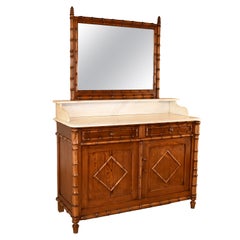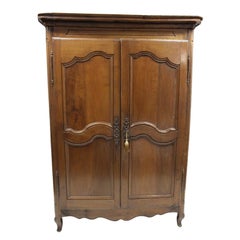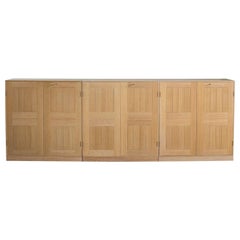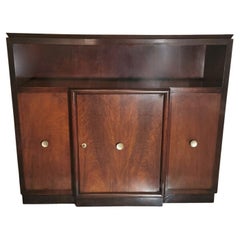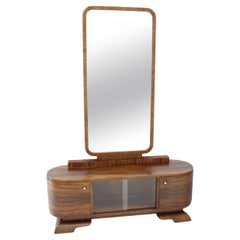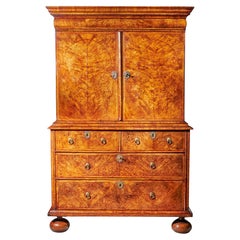European Cabinets
to
1,207
Height
to
Width
to
Depth
to
5,798
2,755
6,329
2,309
103
1,184
1,135
513
491
227
222
207
194
153
142
103
97
72
66
64
64
28
22
870
2,199
3,260
2,412
716
1,816
419
153
28
156
247
201
352
505
251
75
27
7,570
3,276
1,494
1,372
1,364
8,741
2,193
2,065
1,950
1,732
8,741
6,641
6,920
81
74
72
51
38
Place of Origin: European
19th Century French Wash Stand with Mirror
Located in High Point, NC
19th century faux bamboo wash stand from France with the original attached mirror, framed by gorgeous faux bamboo molded framing, sitting atop a marble shelf, which is supported on m...
Category
19th Century Art Nouveau Antique European Cabinets
Materials
Cherry, Pine
18th Century French Walnut Armoire
Located in Savannah, GA
18th century French walnut armoire, peg construction, newer interior shelves.
Category
18th Century and Earlier Antique European Cabinets
Materials
Walnut
Mogens Koch Cabinets in Oak for Rud, Rasmussen
By Rud Rasmussen, Mogens Koch
Located in Copenhagen, DK
Mogens Koch cabinets in oak. Executed by Rud. Rasmussen.
Reverse with paper labels ‘RUD. RASMUSSENS/SNEDKERIER/KØBENHAVN/DANMARK.
Category
Mid-20th Century Scandinavian Modern European Cabinets
Materials
Oak
Art Deco Italian Walnut Cabinet with Doors
Located in Prato, Tuscany
We kindly suggest you read the whole description, because with it we try to give you detailed technical and historical information to guarantee the authenticity of our objects. For t...
Category
Mid-20th Century Art Deco European Cabinets
Materials
Walnut, Pine
1930s Art Deco Mirror Walnut Cabinet, Czechoslovakia
Located in Praha, CZ
- Item has been carefully refurbished
- The mirror dimensions are: height: 125cm, width: 60cm, depth: 6cm
- Quality craftsmanship work.
Category
1930s Art Deco Vintage European Cabinets
Materials
Walnut, Mirror, Wood
Fine 17th Century William and Mary Burl Walnut Cabinet on Chest, Circa 1690
Located in Oxfordshire, United Kingdom
17th century William and Mary burr walnut cabinet on chest, circa 1690. England. Concealing two secret compartments.
The Cabinet
The cross-grain cornice...
Category
17th Century William and Mary Antique European Cabinets
Materials
Walnut, Burl, Oak
Regency Simulated Rosewood Side Cabinet
Located in Bedfordshire, GB
An Extremely Attractive Early 19th Century, Regency Period, Simulated Rosewood Side Cabinet, Having Elegant Parcel Gilt Decoration Throughout, The One Long Drawer Over Two Upholstere...
Category
Early 19th Century Regency Antique European Cabinets
Materials
Birch, Pine
Storet High Chest of Drawers, Nanda Vigo for Acerbis, 1994
By Nanda Vigo
Located in Las Vegas, NV
High Storet chest of drawers in walnut and black by Nanda Vigo for Acerbis, 1994.
Known for her work in visual arts, design, and architecture Nanda Vigo was a trailblazing Italian p...
Category
1990s Modern European Cabinets
Materials
Walnut
Mid-Century Danish Teak Highboard by H.W.Klein for Bramin, 1960s
By Bramin Mobler
Located in Leuven, Vlaams Gewest
Solid teak mid century Danish highboard by H.W.Klein for Bramin.
Labelled at the back
The quality and craftmanship is stunning.
It features 2 big sliding doors, a fold down door a...
Category
1960s Scandinavian Modern Vintage European Cabinets
Materials
Teak
Antique French Marquetry Marble Top Kingwood Bedside Cabinets Locker Nightstands
Located in Dublin, Ireland
Stunning Identical Pair of French Twin Drawer Marquetry and Kingwood marble topped Bedside Lockers Nightstands of outstanding quality, last quarter of the Nineteenth Century.
Each...
Category
Late 19th Century Victorian Antique European Cabinets
Materials
Carrara Marble, Brass
Bar Cabinet with Tambour Doors in Rosewood and Brass by Kurt Østervig, 1960's
By Kurt Østervig
Located in Limhamn, Skåne län
Bar Cabinet with Tambour Doors in Rosewood, Brass and Glass by Kurt Østervig, 1960's
Additional Information:
Material: Rosewood, brass and glass
Style: Mid century, Scandinavian
Pro...
Category
20th Century Scandinavian Modern European Cabinets
Materials
Rosewood
2 mid century modern oak chest of drawers by Bertril Fridhagen for Bodafors
By Bodafors
Located in Houston, TX
A set of mid century modern oak chest of drawers by Bertril Fridhagen for Bodafors, circa 1960s. Designed by Bertil Fridhagen and manufactured for Bodafors in Sweden. In very good or...
Category
1960s Mid-Century Modern Vintage European Cabinets
Materials
Oak
Italian Post Modern Abstract Art Blue Terracotta Brown Steel Mirrored Cabinet
By Cosulich Interiors & Antiques
Located in New York, NY
A new innovative sideboard/credenza, entirely hand-crafted in Italy and completely customizable in sizes, finishes, colors and functions, part of a bespoke collection created as a ca...
Category
2010s Post-Modern European Cabinets
Materials
Metal, Steel
Colosimo Luxury Safe by Döttling
Located in New York, NY
Around the world, Döttling luxury safes find homes among select connoisseurs and enthusiasts of the finest locksmith artisanry. They originate from the Döttling manufactory in Sindel...
Category
21st Century and Contemporary Modern European Cabinets
Materials
Stainless Steel
Escande Cabinet, Cité Universitaire, Antony France
By Escande
Located in Beverly Hills, CA
Rare Escande cabinet manufactured by Marcel Yvroud for Cité Universitaire, Antony, France circa 1954. Oak frames with sliding doors and open niche bookshelves Signature perforated bl...
Category
1950s Vintage European Cabinets
Materials
Metal
Outstanding Quality Large Antique Mahogany Inlaid Satinwood Display Cabinet
Located in Suffolk, GB
Outstanding quality large antique Victorian mahogany inlaid satinwood display cabinet having a quality carved mahogany shaped top above three bevelled edge shaped mirrors and turned ...
Category
19th Century Victorian Antique European Cabinets
Materials
Other
Montana Cabinet Model 1118 Made In Grey By Peter J. Lassen For Montana
By Montana, Peter J. Lassen
Located in Lejre, DK
Montana cabinet, model 1118, designed by Peter J. Lassen and finished in a grey colour. The cabinet is part of Montana's flexible storage system, which is known for its functional an...
Category
Early 2000s Scandinavian Modern European Cabinets
Materials
Wood
French Louis Philippe Style 3-Module Corner Bookcase Lacquered Solid Cherry Wood
Located in Landivy, FR
This bookcase is presented in cherry wood and can also be made in oak.
We can deliver it in 3 modules everywhere and also assemble the modules and install it directly at your plac...
Category
2010s Louis Philippe European Cabinets
Materials
Cherry, Oak
Swedish Rococo Period 1780s Painted Vitrine Cabinet with Molded Bonnet Top
Located in Atlanta, GA
A Swedish Rococo period two-part vitrine cabinet circa 1780 with bonnet top, glass doors, two drawers and additional wooden doors. Showcasing elegant craftsmanship, this exquisite two-part vitrine cabinet from the Swedish Rococo period circa 1780, is an embodiment of refined sophistication. Featuring a stately bonnet top with delicately molded accents, the cabinet lends a distinguished air to any setting. The top section houses two glass doors that reveal a subtly painted grey-blue interior, adorned with shelving for display or storage purposes.
Nestled below the glass doors, the central section holds two gracefully crafted drawers...
Category
Late 18th Century Rococo Antique European Cabinets
Materials
Glass, Wood
Industrial filing cabinet in wood with 30 original cardboard storage boxes
Located in Meulebeke, BE
Belgium / 1920s / filing cabinet / wood and mint site panels, cardboard boxes / mid-century / industrial / vintage design
An exquisite filing cabinet in warm dark wood with 30 origi...
Category
1920s Industrial Vintage European Cabinets
Materials
Metal
Mid century highboard, 1960s
Located in Leuven, Vlaams Gewest
Great looking mid century bar cabinet with beautiful veneer wood and a chrome and wooden base.
The bar cabinet consists of 2 doors and 2 drawers providing loads of storage space.
V...
Category
1960s Mid-Century Modern Vintage European Cabinets
Materials
Wood
Fabulous 18th Century Swedish Rococo Tall Display & Storage Chest
Located in Atlanta, GA
A Swedish Rococo painted wood display and storage cabinet from the 18th century. This antique cabinet from Sweden, which stands just over 7 feet in height, features a gracefully arch...
Category
18th Century Rococo Antique European Cabinets
Materials
Wood
Rare Ico Parisi for Fratelli Rizzi Cabinet or Vanity in Chestnut
By Ico Parisi, Fratelli Rizzi
Located in Waalwijk, NL
Ico Parisi for Fratelli Rizzi, Intimiano, cabinet or vanity, a desk from the same series referenced under cat. no, '1950.56', chestnut, mahogany, brass, mirrored glass, Italy, 1950
...
Category
1950s Mid-Century Modern Vintage European Cabinets
Materials
Brass
Davenport Desk in Walnut, 19th Century
Located in Brussels, Brussels
Superb Davenport in walnut and burl walnut from England from the 19th century V
ery elegant small travel desk in walnut and burl walnut which has a very elegant base
The right side...
Category
19th Century Victorian Antique European Cabinets
Materials
Walnut
Italian Marquetry Walnut Burl Secretary Slant Front Desk Writing Table
Located in Carimate, Como
Very elegant Italian desk, writing table, with slant drop front, with the beautiful light and dark wood inlay decors in classic figures all around the piece and the amazing bronze sc...
Category
Mid-20th Century Belle Époque European Cabinets
Materials
Brass
18th Century French Louis XV Grand Scale Bibliothèque or Display Cabinet
Located in Winter Park, FL
A grand scale 18th century French Louis XV Period bibliothe`que, or bookcase, from the Loire Valley. Made of solid cherry wood with chestnut as a secondary wood and constructed in tw...
Category
18th Century Louis XV Antique European Cabinets
Materials
Iron
Dutch 18th Century Renaissance Oak and Walnut Cupboard
Located in Casteren, NL
This mid-18th century cabinet is a so called 'kussenkast' or pillow cabinet.
The pillow refers to the shape of the raised panels in the doors. It is a ...
Category
Mid-18th Century Renaissance Antique European Cabinets
Materials
Oak
Flemish Early 19th Century Rosewood, Mahogany, Ebony, & Ormolu Specimen Cabinet
Located in West Palm Beach, FL
A spectacular and large scale Flemish early 19th century Rosewood, Mahogany, Ebony, ivory, Tortoiseshell and ormolu specimen cabinet. The fifteen drawer one door cabinet is raised by its original base with six exceptional most decorative turned legs with topie shaped feet below block supports adorned with foliate ormolu mounts each connected by similar beautiful turned stretchers. Above each leg are additional lovely pierced foliate ormolu mounts flanking three drawers each displaying two superb ivory and Tortoiseshell inlaid plaques with intricately detailed scenes depicting hunting and soldiers below the French polished top with a delicate inlaid ivory border. The cabinet above is raised by striking richly chased ormolu claw feet grasping Rosewood balls with a fine double mottled border. At the center is a single door decorated with a beautiful brick like design with soldiers on horses within an arched gateway above inlaid hunting scenes and flanked by impressive Tortoiseshell columns with mottled ormolu plinths and capitals. The door opens to reveal a stunning inlaid checkerboard design with the three original arched mirrors below an impressive dome like design with the door is also finished on the inside with exceptional inlaid geometric designs and the striking original hardware. Flanking the door are four drawers each decorated with two stunning inlaid Tortoiseshell and ivory plaques framed within most decorative mottled wavy borders and displaying foliate ormolu keyhole escutcheons and beautiful pierced plaques and rosettes throughout. Above are three drawers decorated with exquisite etched ivory...
Category
19th Century Baroque Antique European Cabinets
Materials
Bone, Tortoise Shell, Ebony, Mahogany, Rosewood
Mid-Century Oak Cabinet by Gunnar Myrstrand for Källemo, Sweden, 1960s
By Gunnar Myrstrand, Källemo
Located in Karis, Nyland
A cabinet in oak Gunnar Myrstrand for Källemo. Made in the 1960s in Sweden.
The double doors are slightly bent. Behind there are shelves and inner drawers. Brass door pulls.
Overal...
Category
1960s Scandinavian Modern Vintage European Cabinets
Materials
Brass
Oak Arts & Crafts Wall Cabinet with Hand-Carved Stork, 1900s
Located in Amsterdam, NL
Stunning and rare Arts & Crafts wall cabinet.
Striking Dutch design from the 1900s.
Solid oak base with four original drawers with original patinated metal handles.
Hand-carved decor...
Category
Early 1900s Arts and Crafts Antique European Cabinets
Materials
Metal
18th Century Painted Baroque Display Cabinet
Located in London, GB
18th Century painted baroque display cabinet in original Dutch paint.
Category
18th Century Baroque Antique European Cabinets
Materials
Glass, Wood
French 19th C. Wooden Demi-Console w/Faux Marble Painted Top- A Cute Size!
Located in Atlanta, GA
A French painted-wood console cabinet with open cubie and faux marble top from the 19th century. This antique cabinet from France has a half-moon shaped body with a it's original fau...
Category
19th Century Antique European Cabinets
Materials
Wood
Bob Indigo Bar Cabinet
By Garbarino Collections
Located in Milan, IT
This bar cabinet exudes a sophisticated allure that will add a refined accent to a modern interior. Elegant and functional, this piece is composed of four doors boasting a shiny indi...
Category
2010s Modern European Cabinets
Materials
Leather, Glass, Walnut
Vintage Industrial Storage Cabinet
Located in Praha, CZ
Unique vintage industrial wooden shelf cabinet with metal drawers saved from a screw factory. This piece will add that now so modern industri...
Category
Mid-20th Century Industrial European Cabinets
Materials
Metal
French Richly Carved Sideboard Buffet - Renaissance- circa 1580 France
Located in Beuzevillette, FR
Beautiful Renaissance two-body buffet with four doors and six drawers.
On the upper part of the buffet, who hide two secrets drawers, an alternating band of three masks, represents a mythological scene: Zeus changed into a swan seduces Leda on the banks of the Eurotas. The sides of the buffet are decorated with foliage and vines. The doors cornices...
Category
16th Century Renaissance Antique European Cabinets
Materials
Walnut
Fine Rare Pair 17th Century Oyster Walnut Chests on Stands
Located in Lymington, GB
A fine, and rare, very closely-matched pair of late-17th century oyster walnut chests on stands.
English, Charles II period, ca 1685.
Both with f...
Category
17th Century Charles II Antique European Cabinets
Materials
Walnut
21st Century Bowmore Bar Cabinet Wood Made in Portugal by Wood Tailors
Located in RIO TINTO, PT
The Gentlemen’s Club distinguishes itself through its exclusive and singular environment. In order to achieve uniqueness, distinctive pieces are needed, and the Bowmore Bar Cabinet i...
Category
21st Century and Contemporary European Cabinets
Materials
Brass
19th Century Glazed French Painted Buffet Deux Corps - Cabinet
Located in Basingstoke, Hampshire
Introducing a remarkable mid-19th century French glazed cabinet, showcasing timeless elegance and vintage charm. This exquisite piece features a ...
Category
19th Century Antique European Cabinets
Materials
Paint, Pine
2000s USM Haller Second Cycle Credenza C2A Matte Silver 20D x 60W x 30H
By Paul Schaerer, Usm Haller, Fritz Haller
Located in Philadelphia, PA
This is a USM Haller C2A Credenza, originally designed by Fritz Haller and Paul Schaerer in 1963. This particular example was produced by USM in Switzerland in the 2000s. The credenz...
Category
Early 2000s Modern European Cabinets
Materials
Steel
18th Century, French, Armoire in Walnut
Located in Charleston, SC
18th Century French walnut armoire with doors strongly moulded in many curves and counter-curves. The “chapeau de gendarme” cornice richly carved f...
Category
18th Century Louis XV Antique European Cabinets
Materials
Iron
Mid-Century Danish Modern Teak Storage Cabinet
Located in Clarksboro, NJ
This listing is for a Mid-Century Danish Modern Teak Storage Cabinet. Featuring a straight line design, sliding doors on each side that reveal adjustable shelving space, a locking dr...
Category
Mid-20th Century Mid-Century Modern European Cabinets
Materials
Wood, Teak
Contemporary Cabinet 'Bridges' by Muller Van Severen, Medium, Green
By Muller Van Severen, BD Barcelona Design
Located in Paris, IDF
Cabinet 'Bridges' by Muller Van Severen, Medium, Green
Dimensions:
120 x 52 x 140 cm
47,2 x 20,5 x 55,1 in
Model presented:
Bridges
Medium size
Green color
2 Legs
Bridges is a co...
Category
21st Century and Contemporary Organic Modern European Cabinets
Materials
Ash
Antique French Cabinet Carved Oak Demeter Harvest Cornucopia Greek Goddess
Located in Shreveport, LA
Antique French Cabinet Carved Oak Demeter Harvest Cornucopia Greek Goddess.
Direct from France, a beautifully hand carved 19th century French “...
Category
Mid-19th Century French Provincial Antique European Cabinets
Materials
Oak
Italian 1940s Art Deco Mid-Century Walnut Burl and Mirror Mosaic Dry Bar Cabinet
By Vittorio Dassi, Guglielmo Ulrich, Gio Ponti, Paolo Buffa, Ico & Luisa Parisi
Located in Carimate, Como
Very elegant Italian Art Deco Mid-Century Modern drinks dry bar cabinet in beautiful veneer walnut briar burl wood, two doors with great design shaped wooden handles. When opened, on...
Category
Mid-20th Century Art Deco European Cabinets
Materials
Brass
Hand-painted Provincial Cabinet with two Doors, South Germany around 1700
Located in Greding, DE
The painting in light blue and dark gray is new and was designed according to antique models.
Category
Early 1700s Gustavian Antique European Cabinets
Materials
Wood
Blue Painted French Buffet, Mid 19th C.
Located in South Salem, NY
This 19th-century French buffet showcases the elegance of French Louis XIV provincial style. It features two drawers above a cabinet with two doors, adorned with metal hinges that en...
Category
Mid-19th Century Antique European Cabinets
Materials
Wood
Industrial Iron Cabinet with Mesh Doors on Wheels, 1960s
Located in Kojetice, CZ
Iron cabinet from the 1960s it features a green iron construction with mesh doors, two wooden shelwes, a wooden top and two original wheels. The weight of t...
Category
Mid-20th Century Industrial European Cabinets
Materials
Iron
Helios Cabinet in Makassar Ebony with Handle in Corno Italiano, Mod. 7015EBL
By Arcahorn Srl., Filippo Dini
Located in Recanati, Macerata
A handsome housing for your prized belongings, the Helios horizontal cabinet is masterfully crafted from Makassar ebony veneer with lacquered gloss finish. A central backlit handle i...
Category
21st Century and Contemporary European Cabinets
Materials
Brass
Taichiro Nakai Cabinet for La Permanente Mobili, Italy 1960
By La Permanente Mobili Cantù
Located in Amsterdam, NL
This outstanding cabinet is a design by Taichiro Nakai, manufactured by La Permanente Mobili in Italy around 1960.
Made of high quality teak wood in a warm brown colour on a thin, t...
Category
1960s Vintage European Cabinets
Materials
Metal
Art Deco Amsterdamse School Oak Cabinet, 1920s
Located in Amsterdam, NL
Stunning and elegant Art Deco Amsterdamse School cabinet.
Striking Dutch design from the 1920s.
Solid oak base with two original black lacquered metal knobs on the doors.
Both doors ...
Category
1920s Art Deco Vintage European Cabinets
Materials
Glass, Oak
Important Renaissance Cabinet from Lyon 'France' with a Decor of Perspectives
Located in Saint-Ouen, FR
As soon as 1540 France's second Renaissance is in the making, intimately linked to the rediscovery of the Antique world. The development of the printing and engraving industry allows the spread of artworks and models in many cities and countries. The Italian influence can be perceived in every artistic field. While the French king entrust the most talented Italian artists with major projects such as Il Rosso or Primaticcio in Fontainebleau, French artists also travel to Italy to form themselves to this new style. In Italy they get acquainted with the work of Leo Battista Alberti the first to theorize perspective (De Pictura, 1435-36) and architecture (De re oedificatoria, 1541). Those two publications would have a revolutionary impact on arts.
Furniture is marked by the work of the most famous Italian architects of the time as well as French architects. Indeed Philibert de l'Orme competes with Alberti and by the end of his life publishes several treaties including one devoted to a theory of architecture (1567). Unfortunately he would not live to complete the second volume. In this treaty he expresses his interest for mathematical norms applied to architecture, copied from the Antique. His journeys in Italy allowed him to accumulate the most sophisticated references. Jean Bullant, another architect of great talent also theorizes his practice. He establishes rules characterizing Greco-Roman art staying faithful to Vitruvius.
Following this new inspiration the structure of furniture evolves. From then on appear columns, capitals, cornices, friezes and architraves. The ornamentation uses this inspiration as well with egg-and-dart, palm leaf and rose adorning the most beautiful pieces.
In Lyon, crossroad where meet merchants from everywhere those new experiments are welcomed. Lyon florishing printing industry allows the spreading of models and treaties essential to the artist's work. Thus the first publication of Vitruvius' De Architectura in France would be printed in Lyon in 1532.
Artists from Lyon rediscover and familiarize themselves with the Antique knowledge very early. They adopt those new ideas and use them in their own creations. Lyon cabinet-makers re interpret Antique architecture and Italian Renaissance palaces to give their pieces a pure and harmonious architectural structure. Grooved pilasters are particularly favored. They are topped by capitals of diverse orders always respecting the sequencing with simpler ones for the lower levels and the richest ones on the higher levels. As for the ornamentation, one of the great distinctiveness of Lyon workshops remains the architectural perspective illusions, drawing inspiration from Tuscany.
True masterpiece of the Second French Renaissance this important cabinet illustrates Lyon workshops' taste for fine Italian architecture inspired by Antiquity. An architectural perspective of great quality is treated in symmetry on each panel.
This two-bodied cabinet without recess stands on four rectangular feet. The base comprises a molding, a palm leaf frieze and is bordered by a braid.
The lower body is divided by three grooved pilasters with Tuscan capitals framing two door-leaves. The two panels are encircled by a moudled frame with palm leaves. They are finely carved with a decor of fantasized architecture depicting an Italian Renaissance palace erected symmetrically on each side of a grooved pilaster. On the ground floor a door opens through a stilted arch while the stories are opened with mullioned windows, dormers and occuli. Two large pegged-boss cladded pillars support the entablature enriched by a palm leaf frieze upon which stands an arch whose coffered intrados is centred by a rose. Behind this arch a pyramid appears, standing in front of a second facade with a window topped by a broken curvilinear pediment under a cul-de-four with a shell.
The checker flooring gives depth to the low-reliefs creating vanishing points structuring the panels and guiding the eye of the observer.
A thin laurel braid highlights the belt of the cabinet where are located two drawers. Their facades are adorned by palm leaves in hoops.
The upper body is encircled with palm leaves. The same ternary division as in the lower body appears. However, the pilasters are topped by Ionic capitals with volutes and egg-and-dart. The door-leaves are framed with flowers. On the panels the artist has designed another architectural decor. On the foreground open two arches on top of grooved pilasters with rectangular capitals adorned with palm leaves. The arches are enriched with braids and the coffered intrados bears a decor of roses. The spandrels also bear a flower decor. In the background another arcature hosts a fluted grooved column topped with double basket acanthus capital, characteristic of Corinthian order. The triangular pediment is interrupted by a choux bourguignon.
A large cornice crowns the cabinet. It stands on pilasters and forms an entablature comprising a palm leaf frieze and an egg-and-dart, triglyph and palm leaf cornice.
The cabinet's sides have also been carefully considered. The lower body's panels are enriched with an arch rising above a broken pediment portico hosting a twisted column. Flowers garnish the spandrels. An architectural facade completes the decor. The upper body's panels present two arches supported by a facade opened with dormers and mullioned windows as well as cartouches (one bears the inscription 1580 dating the cabinet) suggesting the interior of an Italian Renaissance palace, confirmed by the chandeliers. The flooring leads our gaze to a second arch with a broken curvilinear pediment where stands a flower vase. This arch opens onto a perspective of another facade along a road.
Inside the cabinet, on the lower body door-leaves appear two designs. On the right door is depicted a Crucifixion. Saint Mary and Saint John flank the Christ on the cross. In the bottom part is inscribed « Dure uiator abis nihil haec spectacula curas / Pendenti cum sis unica cura Deo. / Tota suo moriente dolet natura Magistro. / Nil qui solus eras caussa dolenda doles. ». The signature [Christoff Swartz Monachiensis pinx[it] / Ioa[nnes] Sadeler sculp[it]] tells us it was made by Johan Sadeler I (1550-1600) after Christoph Schwartz (1548-1592). This engraving belongs to an ensemble depicting the Passion of Christ Johan Sadeler executed in 1589 after an altar piece painted by Christoph Schwartz for the private chapel of Renée of Loraine, wife of Duke William V of Bavaria. This altar piece made of nine copper panels has been destroyed during the 19th century. The Crucifixion panel once in the centre of the altar piece is the only one that survived and is today kept in Munich's Alte Pinakothek.
On the left door appears Saint Francis receiving the stigmata. The inscription says : « Signastidomine Servum Tuum. Franciscum. Signis Redemptionis Nostrae ».
This Renaissance cabinet with an architectural decor appearing as much in the structure faithful to Antique rules...
Category
16th Century Renaissance Antique European Cabinets
Materials
Walnut
1950s Regency Pietra Dura Style Painted Mahogany Demilune Cabinet
Located in Kennesaw, GA
This is a 1940s/50s Regency Pietra Dura style painted flame mahogany demilune cabinet. It has a nice brass gallery and single interior shelf. The beautiful painted top is in the mann...
Category
1950s Regency Vintage European Cabinets
Materials
Brass
Rare Princess Diana's Althorp Estate Living History Collection Library Bookcase
By Brights of Nettlebed, Theodore Alexander
Located in West Sussex, Pulborough
We are delighted to offer for sale this very rare, now discontinued, Thomas Chippendale Library bookcase which is an exact authorised copy of one from Princess’s Diana’s family home, the Althorp Estate, it was part of the Living History collection, made by Theodore Alexander and retailed through Brights of Nettlebed and has touch activated top lights
The Althorp estate is widely considered one of, if not the finest English country home left standing. You can see clips of the tours online, the place is an absolute marvel of English history.
The estate is owned, and has been by the Spencer family’s for over 500 years, I’ll include the history below. The estate is currently in the stewardship of the Earl of Spencer, Princess Diana’s brother
The bookcase itself is very fine, in flamed mahogany and has glass shelves and top spot lights which are activated by touching any one of the three right door hinges, each light has three dimness settings. The piece is fully stamped for Theodore Alexander the maker on the locks, Brights of Nettlebed for the retailer and the right drawer has what looks to be pewter, Althorp family crest inside.
This bookcase breaks down into five easy to transport pieces, you have the base which is one unit, the three top bookcase sections are all separate and the top cornice is also one removable piece
Condition wise this piece is exquisite, there is very little in terms of wear or use, it has been cherished since new and is a very fine piece indeed
Dimensions
Height:- 233cm, the brass urns on the very top can be unscrewed if ceiling height is an issue, they are 11cm tall each
Width:- 167cm
Depth:- 50.5cm
Please note all measurements are taken at the widest point
Althorp history
Althorp (popularly pronounced /'??l???rp/ AWL-thorp) is a Grade I listed stately home and estate in the civil parish of Althorp, in West Northamptonshire, England of about 13,000 acres (5,300 ha). By road it is about 6 miles (9.7 km) northwest of the county town of Northampton and about 75 miles (121 km) northwest of central London, situated between the villages of Great Brington and Harlestone. It has been held by the prominent aristocratic Spencer family for more than 500 years, and has been owned by Charles Spencer, 9th Earl Spencer since 1992. It was also the home of Lady Diana Spencer (later Princess of Wales) from her parents' divorce until her marriage to Charles, Prince of Wales.
Althorp is mentioned as a small hamlet in the Domesday Book as "Olletorp", and by 1377 it had become a village with a population of more than fifty people. By 1505 there were no longer any tenants living there, and in 1508, John Spencer purchased Althorp estate with the funds generated from his family's sheep-rearing business. Althorp became one of the prominent stately homes in England. The palace dates to 1688, replacing an earlier house that was once visited by Charles I. The Spencer family amassed an extensive art collection and other valuable household items. During the 18th century, the house became a major cultural hub in England, and parties were regularly held, attracting many prominent members of Great Britain's ruling class. George John, 2nd Earl Spencer, who owned Althorp between 1783 and his death in 1834, developed one of the largest private libraries in Europe at the palace, which grew to over 100,000 books by the 1830s. After falling on hard times, John Spencer, 5th Earl Spencer, known as the Red Earl, in 1892 sold much of the collection to Enriqueta Rylands, who was building the University of Manchester Library. Many of Althorp's furnishings were sold off during the twentieth century, and between 1975 and 1992 alone approximately 20% of the contents were auctioned.
The house at Althorp was a "classically beautiful" red brick Tudor building, but its appearance was radically altered, starting in 1788, when the architect Henry Holland was commissioned to make extensive changes. Mathematical tiles were added to the exterior, encasing the brick, and four Corinthian pilasters were added to the front. The grand hall entrance to the house, Wootton Hall, was cited by Sir Nikolaus Pevsner as "the noblest Georgian room in the county". The Great Dining Room in the east wing extension of the house was added in 1877 to designs by John Macvicar Anderson, its walls hung with faded, red damask silk. Numerous fireplaces and furnishings were brought to Althorp from Spencer House in London during the Blitz for safekeeping and still remain. The Picture Gallery stretches for 115 feet (35 m) on the first floor of the west wing, and is one of the best remaining examples of the original Tudor oak woodwork and ambiance in the mansion. It has an extensive collection of portraits, including Anthony van Dyck's War and Peace, a John de Critz...
Category
20th Century Chippendale European Cabinets
Materials
Glass, Hardwood
Swedish Cabinet attributed to Oscar Nilsson, 1930s Nordic Scandinavian
By Oscar Nilsson
Located in West Palm Beach, FL
Swedish cabinet attributed to Oscar Nilsson, with carved wood doors. Made in 1930s. Nordic Scandinavian.
Category
1930s Vintage European Cabinets
Materials
Wood
Modern Contemporary Boxes in Orange and Green Mdf by Marc Morro
Located in Barcelona, ES
Olmo are a pair of stackable boxes with 2 different heights. They are made with different layers of MDF and plywood, what creates a light and resistant structure that allow them to s...
Category
21st Century and Contemporary Modern European Cabinets
Materials
Beech
Tolix B1 H45 Locker Perforated Indoor Painted with Wood in Graphite
By Tolix
Located in Shakopee, MN
- The B1 H45 is the smallest member in TOLIX®'s perforated Locker family. The cube shape is perfect for small spaces like a student's room or studio...
Category
21st Century and Contemporary European Cabinets
Materials
Steel
Restored Biedermeier Display Cabinet, Maple, Walnut, Polish, Czech, 1850s
Located in Brandys nad Labem, Středočeský kraj
This elegant Biedermeier display cabinet comes from Bohemia from the mid-19th century. It is made of a combination of walnut and maple wood and has undergone careful restoration. Dur...
Category
1850s Biedermeier Antique European Cabinets
Materials
Glass, Wood, Walnut, Lacquer, Maple
Cabinet 19th Century, Napoleon III Period, Style Boulle
By André-Charles Boulle
Located in Warsaw, PL
This wooden cabinet is designed in the Boulle style. This style was very popular around the time of Napoleon III. The characteristic of this style is the use of small pieces of wood in furniture, inlaid designs with many different materials: precious wood, precious stones, enamel, ivory, seashells, metal, marble etc. In addition, to express the royal style, the "Boulle" style also uses a large amount of gilded copper on the furniture, such as tiger claw decoration, mirror border decoration, leaf decoration, etc.
The main elementsof this cabinet is ebony and turtle shell, with decorative details and gilded legs. This is a pretty prominent highlight in the overall black and gold color scheme. Moreover, the head of a woman is in the middle of the cabinet with waves in her hair and grape vines could be representing the Greek goddes of spring Spring. Surrounding the head are beautiful acanthus motifs incorporated in every layer and surface of the cabinet. Symmetricallly on the left and right side of the head are two identical faces, with one being the lock of the cabinet where key goes. The four corners of the cabinet have blooming carnations to create a feeling of spring coming. The details are collaged, decorated with golden bronze leaves in a classic French style. On the edges of the cabinet are sculptures of two women wrapped around with cloth and leaves. Through it, the author highlights the beauty of the woman's status in the past. On the side panels of the cabinet is placed a gilded face of a man with wings...
Category
19th Century Louis XIV Antique European Cabinets
Materials
Bronze
Recently Viewed
View AllMore Ways To Browse
Amberg File Cabinet
Ambergs Cabinet Letter File
Ambergs Imperial Letter File
American Rustic Armoire
Anton Pospischil On Sale
Arhaus Console
Armoire Sinatra
Art Deco Hi Fi Bar
Atelier Eb
Attic Heirloom
B B Italia Antonio Citterio Titanes Dresser
B B Italia Antonio Citterio Titanes
Baisch Dental Cabinet
Baker Stately Homes Chippendale Bookcase
Bangkok Cabinet By Yngve Ekstrom
Black Forest Hutch
Bow Front Hutch
Yngve Ekstrom Bangkok
